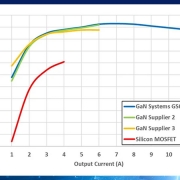Article: Analyzing the Advantages of 100V GaN in 48V Applications
This technical article from Lei Kou, Power Electronics Applications Engineer at GaN Systems, and Juncheng (Lucas) Lu, GaN Systems Applications Engineering Manager, appears in full here at EE Power.
This article describes an ultra-low parasitics Eon/Eoff measurement platform and the advantages of 100V GaN in 48V applications.
Why 48V? I2R conduction losses in a system can be detrimental to system efficiency and can reduce the power flow to the load effectively given cable, connector and/or PCB limitations. As an example, server processor power has increased from 100W-200W to 400W and higher. Distributing this increased power to multiple server processors creates more losses unless mitigated by higher voltage distribution or larger copper bus bars. The conventional datacenter/server power architecture is illustrated in Figure 1(a), where all major processor/ memory devices are powered from a 12V bus. The I2R loss for a 12V bus is excessive, and there are many energy conversion stages, which reduces the total system efficiency. To mitigate the heavy busbar loss and reduce energy conversion stages in the power distribution path, a 48V bus datacenter/server architecture is shown in Figure 1(b). This power architecture has an advantage over current design practices by eliminating online UPS, cables, and harness. The trend clearly shows that the power conversion benefits from 48V bus with more energy-saving and lower expenditure (CAPEX and OPEX).
With “more power in less area” being the norm, moving from 12V to 48V power distribution using high-frequency power transistors allows engineers to meet their efficiency, cost and size/weight metrics.
The GaN Systems 100V product line is a solid solution candidate for 48V applications that meets high frequency, high efficiency, and high-power density power conversion requirements. Compared to MOSFETs, GaN transistors have a wide bandgap, high electron mobility, and high electron velocity to allow the system switching frequency to be pushed up to high kHz and MHz frequencies to maintain high efficiency and increase power density.
Read the rest of Analyzing the Advantages of 100V GaN in 48V Applications” here at EE Power.


